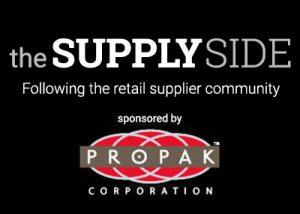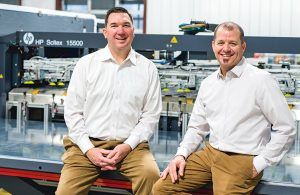The Supply Side: Tango Press looks to fill digital production demand
by May 18, 2017 1:52 pm 1,049 views

Given the setup costs associated with off-set printing, boxes printed with colorful graphic designs and display stands used at retail have been a challenge when needed in smaller quantities.
John Ballentine saw a business opportunity in the challenge.
Ballentine, a veteran in the corrugated industry, noticed the niche opportunity in his graphic printing sales job for International Paper. As digital printing for corrugated cardboard became more cost efficient, Ballentine saw a need for smaller, more detailed graphic runs, something the larger production houses operating on quantity couldn’t justify.
That’s when he teamed up with Steve Toth, a former Honeywell executive with experience in business systems and management. The duo dug into their savings and with the help of First National Bank of NWA was able to achieve a U.S. Small Business Administration loan to open a small digital corrugated enterprise called Tango Press located in Springdale.
The Tango team has spent more than $2 million on their facility and state-of-the-art digital press and cutter for corrugated boxes used by suppliers ranging from DeWalt tools to Hanna’s Candles.
Tango operates in a 15,000-square-foot facility near Interstate 49 and Sunset in Springdale, in the former space occupied by Sam’s Furniture’s scratch and dent facility. Inside, the HP Scitex 15500 digital press and the Fund G3 digital cutter have run small jobs for retail suppliers such as Tyson Foods, small businesses and local retail startups such as Fayetteville-based Menguin.
Toth said the digital press is one of just 30 in the world. He said the press was installed in September by HP, and Tango began running jobs in October. The press can print large 10-foot by 5-foot sheets of corrugated cardboard at a rate of 120 sheets per hour. He said that’s about 48,000-square-feet of printing production in a typical eight-hour day. The press is capable of intricate graphic designs in any color customers want.
 Tango does not employ a graphic designer, but contracts with them as needed. Toth said many clients have graphic artists on staff, and Tango works with them to secure the art which is programed into the press and then the digital cutter.
Tango does not employ a graphic designer, but contracts with them as needed. Toth said many clients have graphic artists on staff, and Tango works with them to secure the art which is programed into the press and then the digital cutter.
He said the digital cutter scores the cardboard and cuts along the cutlines which are then folded to make the box or display. He said the graphics have to appear right once the cardboard is folded, but the machine does a great job lining up the graphics in the correct spots. He said the machines are programed to print and cut on precision.
Toth said Tango is still running at a low capacity as the company tries to get the word out about its services. It has picked up a number of wholesale jobs for larger print houses that don’t want to run the smaller jobs, or those that require intricate detailed graphics. When asked how Tango differs from some of the prototype print services in the area, Toth said they are not into prototypes but rather a production house. He said they can help people with their prototype, but it’s not Tango’s sweet spot. He said the company works to provide print solutions for customers who have a plan in mind.
For instance, Tango recently constructed custom boxes for Menguin that had to be black with color graphics of the logo. Toth said the gift boxes were for new employees and had to be designed to hold a laptop. The other items such as a T-shirt and coffee mug were also made to stand up in the box as if they were being presented when the box was opened. Not only did Tango make the sleek black gift box, but it also made the partitions and display units on the inside of the box so that each item was displayed and yet firmly secure in the box.
Toth said Tango continues to make cardboard displays for Wal-Mart supplier Burt Hanna. He said the cardboard displays must have different graphics that go with the multiple candle scents sold on the same display. Hanna supplies Great Value wax melts and ceramic diffusers for Walmart Mexico, and those display cases are made at Tango Press in Springdale.
ANALOG TO DIGITAL
Ballentine said what used to take six to eight weeks to complete can now be designed and produced in one day as the industry is changing from analog to digital.

According to the Smithers Pira report, the estimated worth of the digitally printed packaging market in 2013 was $6.6 billion, and forecast to more than double to $14.4 billion by 2018. The report also expects digitally produced packaging to increase by 375% by 2018, compared to just 28% growth in traditional analog systems.
“With the resources we have at Tango, we can dramatically compress the concept-to-commercialization timelines on every project,” Ballentine said.
Not only can smaller jobs be done quickly, but Toth said digital printing ensures each copy is a match to the last one off the press. He said with analog printing, humidity can affect the coloring, and some copies can have color differences. The digital press used by Tango can replicate six colors with 52 printheads per color. He said the company recently did a small run for Tyson Foods and replicated the Tyson logo which registered 4 Delta-E with Tyson’s own spectrophotometer and that surprised the customer, because the exact match has been hard to achieve in the past.
THE EXTRA MILE
Toth said they were running a job for a customer that furnished all their art and print and cut specs. This was for a product display used in Home Depot. He said they ran a few and then tried to punch out the cuts and fold and assemble the display. He said they noticed the display was hard to assemble and found the issues were in the directions the customer supplied for the cuts. Tango reworked the design and made the change in the system for the customer so the product would be easy to assemble by the retail worker on the sales floor.
“We know if retail workers on the sales floor are very busy, they don’t have time to mess with a poorly designed display,” Toth said. “If it doesn’t fold and assemble quickly they could just discard it and that would be bad for our customer. We went the extra mile and fixed their design so that we could deliver a product that worked for them.”
Another industry change advantageous for Tango is that companies don’t need to stock a warehouse full of boxes. They are more likely to order for on- demand and just-in-time inventory purposes.
Toth said digital printing can be done at a fixed cost, while analog printing has the majority of costs around upfront tooling which requires larger quantities to bring the cost down.
–––––––––––––––––––––
Editor’s note: The Supply Side section of Talk Business & Politics focuses on the companies, organizations, issues and individuals engaged in providing products and services to retailers. The Supply Side is managed by Talk Business & Politics and sponsored by Propak Logistics.
